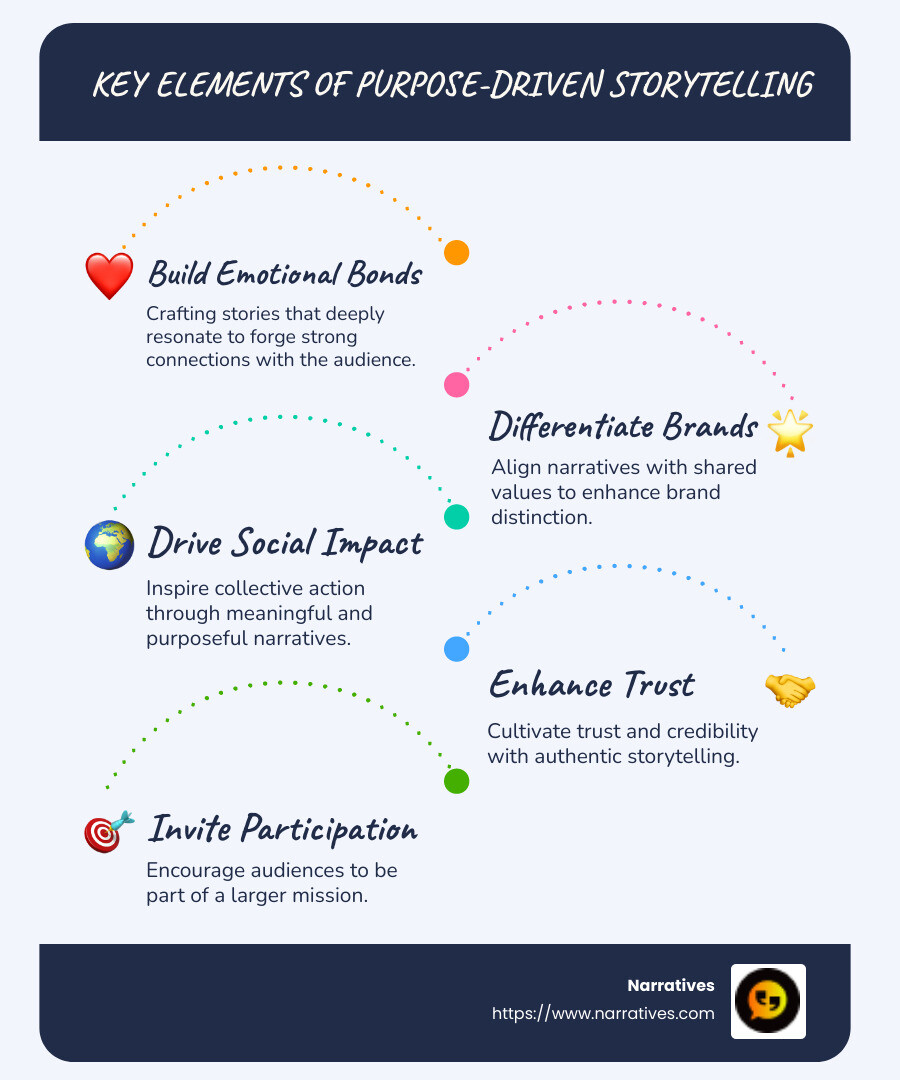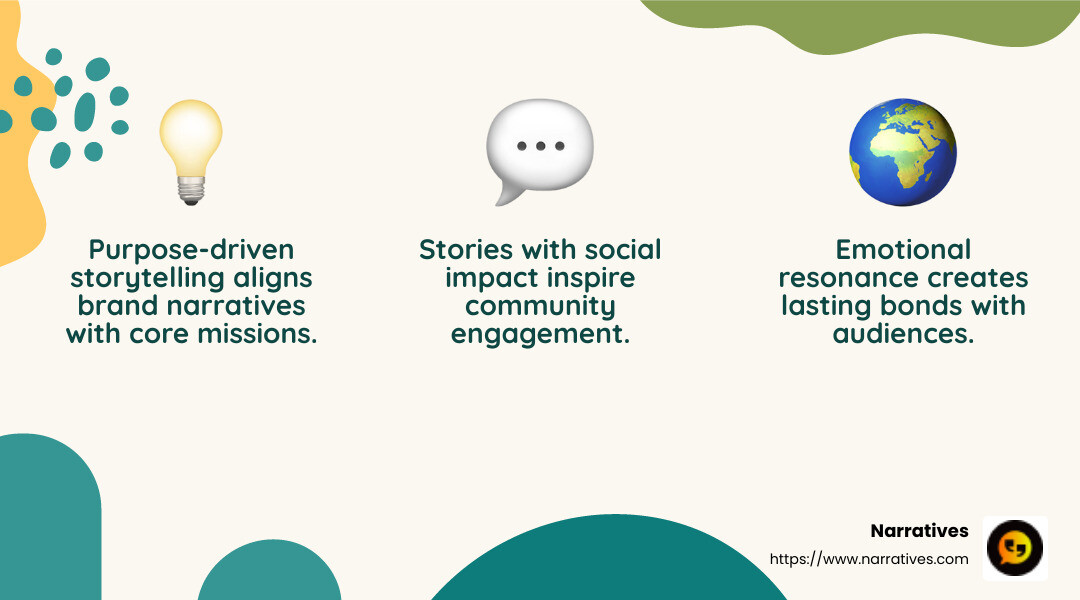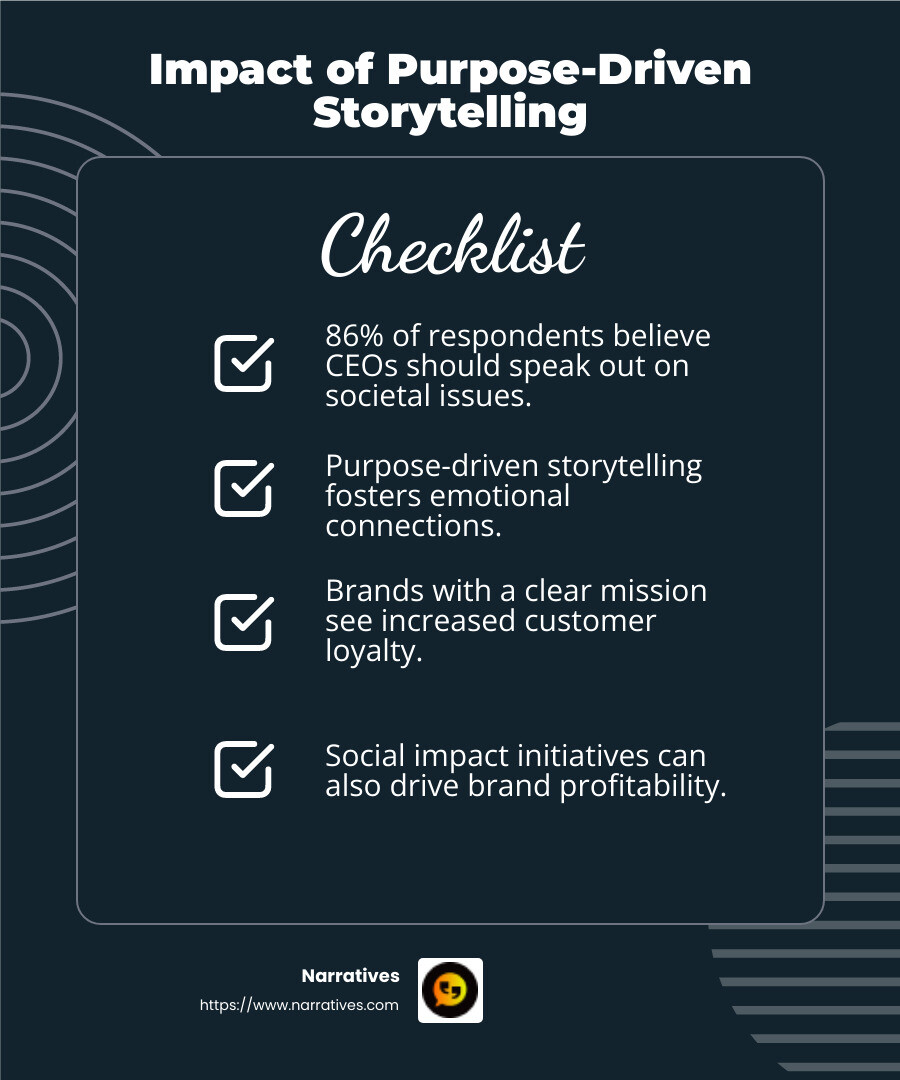The Power of Purpose: Storytelling That Inspires and Connects

Storytelling with Purpose: Forging Emotional Connections
Purpose-driven storytelling is a powerful tool that creates emotional bonds between a brand and its audience. By aligning narratives with values and missions, organizations can inspire action, foster loyalty, and drive meaningful change. Here's how it works in a nutshell:
- Build Emotional Bonds: Stories that resonate deeply build strong connections.
- Differentiate Brands: Aligning with shared values makes brands stand out.
- Drive Social Impact: Purposeful narratives can inspire collective action.
- Improve Trust: Authentic stories cultivate trust and credibility.
Purpose-driven storytelling goes beyond just selling products; it’s about sharing a mission that your audience can believe in and support. It taps into emotions, inspiring people to not only engage with the brand but also champion the causes it stands for.
Mastering the art of purpose-driven storytelling involves crafting tales that are true to the brand’s mission and that emotionally engage diverse audiences. This approach not only helps businesses connect with their stakeholders but also amplifies their impact on society.
By weaving these narratives, you’re not just telling a story; you’re inviting others to be part of something bigger and more meaningful.

Terms related to Purpose-driven storytelling:
Understanding Purpose-Driven Storytelling
Purpose-driven storytelling is more than just a buzzword; it's a way to connect deeply with your audience by aligning your brand's narrative with its core mission.
The Essence of Purpose-Driven Storytelling
At its heart, purpose-driven storytelling is about conveying a brand's mission in a way that resonates emotionally with its audience. This method of storytelling is not just about the product or service but about the "why" behind the brand. It's about creating stories that reflect the brand's values and mission and that inspire people to be part of something meaningful.
Emotional Resonance
Stories have the power to evoke emotions. When a brand tells a story that resonates emotionally, it creates a lasting bond with its audience. For instance, TOMS Shoes shares stories of individuals in underserved communities who have benefited from their "One for One" program. These stories tug at the heartstrings and drive engagement by focusing on the human impact of their initiatives.

Aligning with Brand Mission
A brand's mission is its guiding star. Purpose-driven storytelling must be anchored in this mission to be effective. Patagonia, for example, is known for its commitment to environmental sustainability. Their storytelling consistently reflects this mission, reinforcing their brand identity and attracting consumers who share these values.
By weaving stories that are true to their mission, brands can differentiate themselves in a crowded market. This alignment not only attracts like-minded customers but also builds trust and loyalty.
The Power of Authenticity
Authenticity is crucial in purpose-driven storytelling. Consumers are savvy and can easily detect when a brand is being disingenuous. Brands must ensure their actions align with their storytelling. This authenticity fosters trust and credibility, which are essential for building long-term relationships with consumers.
Conclusion
In summary, purpose-driven storytelling is a powerful tool for brands to connect with their audience on a deeper level. By aligning stories with their mission and evoking emotional resonance, brands can inspire action, foster loyalty, and drive meaningful change. This approach not only helps businesses connect with their stakeholders but also amplifies their impact on society.
The Impact of Purpose-Driven Storytelling
Purpose-driven storytelling has a profound impact on how brands connect with their audience. By tapping into emotions and aligning with a clear mission, brands can foster strong emotional connections, build lasting loyalty, and drive social change.
Emotional Connections
Stories have a unique ability to evoke emotions. When a brand tells a story that resonates, it creates a deep emotional connection with its audience. This connection is more than just a fleeting feeling; it's a bond that can turn casual customers into passionate advocates. For example, a company might use initiatives to share stories of individuals in need who have benefited from their products or services. These narratives tug at the heartstrings and inspire action, demonstrating the real-world impact of their mission.
Building Brand Loyalty
Emotional connections pave the way for brand loyalty. When customers resonate with a brand's values and mission, they are more likely to stay loyal over the long term. Purpose-driven storytelling helps brands differentiate themselves in a crowded market by offering more than just a product or service. It's about creating a shared journey with the audience. Companies that consistently weave their commitment to important causes into their storytelling not only attract like-minded consumers but also foster a sense of belonging and loyalty.
Driving Social Impact
Purpose-driven storytelling isn't just about building connections and loyalty; it also has the power to drive social change. By highlighting important issues and inspiring collective action, brands can make a meaningful impact on society. Investors are increasingly recognizing the value of investing in purpose-driven startups, as these businesses often combine strong financial prospects with a clear mission for social good. Brands that successfully balance profitability with social impact prove that purpose-driven initiatives can thrive in today's market.

Purpose-driven storytelling is a catalyst for change. It not only helps brands connect with their audience on a deeper level but also amplifies their impact on the world. By sharing stories that align with their mission and values, brands can inspire action, foster loyalty, and drive meaningful social change.
Techniques for Effective Purpose-Driven Storytelling
Creating a compelling purpose-driven storytelling strategy requires more than just a good story. It involves authenticity, emotional resonance, and visual storytelling. Let’s break these down.
Authenticity
Authenticity is the backbone of effective storytelling. Audiences are quick to spot insincerity. For a brand, this means being genuine in its commitment to its mission. Take Dove's "Real Beauty" campaign. It challenges beauty stereotypes with real stories and images of diverse women. This genuine approach resonates because it aligns with Dove’s mission to celebrate diversity and self-esteem.
- Be transparent: Share your values and the challenges you face.
- Stay true to your mission: Align every story with your brand’s core values.
Emotional Resonance
Stories that evoke emotions create lasting impressions. They go beyond facts and figures, tapping into what makes us human. Emotional resonance is about creating stories that your audience can feel deeply.
- Focus on human-centric stories: Highlight individuals or communities positively impacted by your brand. TOMS does this well by sharing stories from communities that benefit from their shoe donations.
- Use relatable scenarios: Make your audience see themselves in your story, fostering empathy and connection.
Visual Storytelling
Visual storytelling improves the narrative by making it more engaging and memorable. Images, videos, and infographics can convey complex messages quickly and effectively.
- Use strong visuals: Capture emotions and actions that words alone can't express. Patagonia often uses stunning visuals of nature to underscore their environmental commitment.
- Incorporate multimedia elements: Videos and infographics can simplify complex issues and make them more accessible.
In summary, effective purpose-driven storytelling combines authenticity, emotional resonance, and visual elements to create narratives that inspire and connect. These techniques not only help in building trust but also in engaging audiences on a deeper level.
Next, we’ll explore how non-profit organizations leverage these techniques to amplify their social impact and foster community-driven storytelling.
Purpose-Driven Storytelling in Non-Profit Organizations
Non-profit organizations have a unique advantage when it comes to purpose-driven storytelling. Their missions often revolve around social impact, making their stories inherently compelling and emotionally resonant. Let's dig into how these organizations use storytelling to foster partnerships, drive social change, and build community-driven narratives.
Non-Profit Partnerships
Non-profits often collaborate with businesses and other organizations to amplify their impact. These partnerships are built on shared values and goals, making storytelling a key component in communicating these alliances.
Highlight Shared Goals: Effective storytelling in partnerships focuses on common objectives. For instance, the Pars Equality Center collaborates with various organizations to support Persian-speaking immigrants. Their stories highlight how these partnerships empower communities through legal assistance and cultural integration.
Showcase Joint Impact: Sharing success stories from partnerships can demonstrate the tangible outcomes of collaborative efforts. This not only strengthens the partnership but also attracts more supporters.
Social Impact
Non-profits are driven by the desire to create positive change. Purpose-driven storytelling helps them communicate their social impact effectively.
Use Real Stories: Sharing real-life stories of individuals or communities transformed by the organization's work can create a strong emotional connection. TOMS, for example, shares stories of people who have benefited from their "One for One" program, creating a narrative that tugs at the heartstrings.
Inspire Action: Stories that highlight social impact can motivate audiences to take action, whether it's donating, volunteering, or spreading the word. This is crucial for non-profits looking to grow their support base.
Community-Driven Storytelling
Non-profits thrive on community engagement. By involving the community in their storytelling, they can create narratives that resonate deeply and foster a sense of belonging.
Empower Voices: Allow community members to share their own stories. This not only enriches the narrative but also empowers individuals by giving them a platform. Narratives exemplifies this by working with underrepresented storytellers to highlight community issues and solutions.
Build Movements: Community-driven storytelling can transform individual stories into larger movements. By rallying people around a shared purpose, non-profits can drive collective action and inspire change.
In summary, non-profit organizations leverage purpose-driven storytelling to highlight their partnerships, showcase their social impact, and engage communities. These narratives not only build trust and loyalty but also inspire action and foster a sense of belonging.
Next, we’ll tackle some common questions about purpose-driven storytelling and its role in building trust and loyalty.
Frequently Asked Questions about Purpose-Driven Storytelling
What is purpose-driven storytelling?
Purpose-driven storytelling is the art of weaving a brand's mission into a compelling narrative. It's about creating stories that connect emotionally with the audience by aligning with their values. This approach helps brands communicate their core mission effectively. When done right, it fosters a deeper connection, making the brand more relatable and memorable.
How can storytelling build trust and loyalty?
Storytelling is a powerful tool for building trust and loyalty. Here’s how it works:
Authenticity: People are drawn to brands that are genuine. Authentic stories show the real side of a brand, making it easier for people to trust them. When brands share honest narratives about their journey, challenges, and achievements, it resonates with audiences on a personal level.
Emotional Resonance: Stories that evoke emotions are memorable. They create a lasting impression that facts and figures alone can't achieve. When a brand story touches the heart, it strengthens the emotional bond with the audience, leading to increased loyalty.
Consider the example of Patagonia, a brand known for its commitment to environmental causes. Their stories about sustainability and ethical practices are not just marketing tactics. They reflect the brand's true mission, creating trust and loyalty among environmentally-conscious consumers.
Why is purpose-driven storytelling important for non-profits?
Non-profits thrive on purpose-driven storytelling because it amplifies their social impact and engages the community effectively.
Social Impact: Non-profits often have missions centered around making the world a better place. By sharing stories of change and transformation, they can showcase the tangible impact of their work. This not only highlights their achievements but also inspires others to contribute to their cause.
Community Engagement: Engaging the community is vital for non-profits. By involving community members in their stories, non-profits can create narratives that resonate deeply. This approach fosters a sense of belonging and encourages collective action.
For instance, Narratives collaborates with underrepresented storytellers to highlight community issues. This not only empowers individuals but also builds a strong, engaged community around shared values and goals.
Through purpose-driven storytelling, non-profits can effectively communicate their mission, build trust, and inspire action. These narratives are essential for fostering a supportive and engaged community.
Conclusion
As we wrap up our exploration of purpose-driven storytelling, it's clear that this approach is not just a marketing tactic—it's a strategic necessity for organizations looking to make a lasting impact. At Narratives, we understand the power of stories to connect, inspire, and transform. By partnering with non-profits and purpose-driven organizations, we aim to lift voices that often go unheard, helping them share their impact in a compelling way.
Our strategy focuses on creating high-quality, emotionally resonant content that builds trust and increases visibility. This approach not only improves brand loyalty but also establishes domain authority by owning storytelling-related keywords. By differentiating from competitors through our focus on non-profit partnerships and community-driven storytelling, we are setting a new standard in digital storytelling.
When attention is scarce, purpose-driven storytelling serves as a guide, guiding brands and audiences toward a shared and meaningful future. Whether it's through emotionally engaging videos or impactful community stories, our goal is to help organizations inspire action and foster a sense of community.
As we continue to build our storytelling strategy, we invite you to join us on this journey. Together, we can create narratives that not only resonate but also drive real change. If you're ready to harness the power of storytelling for your organization, learn more about how Narratives can help.


